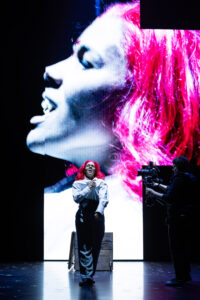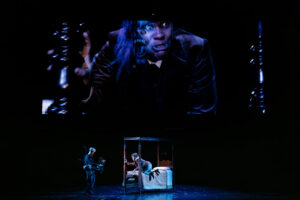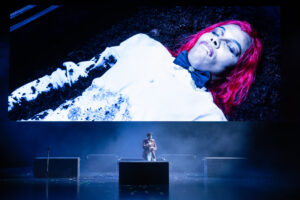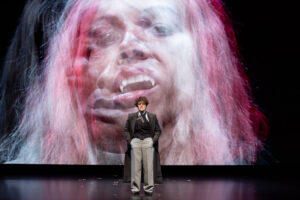Roslyn Packer Theatre, July 6
7.5/10

Sometimes the images are laid atop one another, like so many memories clamouring for focus in a brain. Sometimes the visual effect is wondrous, as when the characters of Holmwood, Morris and Van Helsing seem real rather than on a screen as they converse with the live John Seward, echoing the unforgettable dinner party scene in The Picture of Dorian Gray.
Dracula is the third and final instalment of the gothic cine-theatre trilogy that began with Dorian Gray (2020, and now playing in London) and Strange Case of Dr Jekyll & Mr Hyde (2022), devised by Sydney Theatre Company’s departing artistic director, Kip Williams. In case you’ve been hiding in a grave in Transylvania, cine-theatre makes combines live video of real-time acting with pre-recorded images.
Playing all 23 roles is the gifted Zahra Newman. The characters may appear exclusively on screen, or be defined by wig and costume changes made before our eyes. Yet, as good as Newman is, especially in her vocal variation, Dracula doesn’t work as well as its predecessors. Firstly, it’s simply not scary enough. For all the B-grade movies it has engendered, Bran Stoker’s 1897 novel is genuinely unsettling, whereas when Williams’s rendition reaches for gothic horror, the audience laughs.
 Given the constant presence of extraordinarily diverse music (written or selected by Clemence Williams) it’s possible Williams’ intention was to satirise hyperbolic melodrama. That would seem odd, however, when he was previously so keenly attuned to serving the intentions of Oscar Wilde in Dorian Gray and Robert Louis Stevenson in Jekyll & Hyde. Stoker may be a lesser writer, but if one seriously wanted to lampoon his work, it could be much funnier than this.
Given the constant presence of extraordinarily diverse music (written or selected by Clemence Williams) it’s possible Williams’ intention was to satirise hyperbolic melodrama. That would seem odd, however, when he was previously so keenly attuned to serving the intentions of Oscar Wilde in Dorian Gray and Robert Louis Stevenson in Jekyll & Hyde. Stoker may be a lesser writer, but if one seriously wanted to lampoon his work, it could be much funnier than this.
The cemetery scene is certainly creepy with its confusion of crosses, and Newman looks startling enough when she’s playing the titular character in a cerise wig. But one might have hoped for at least one moment when you were inclined to grab the person next to you, if not run screaming from the room.
 Put the scariness issue to one side, and the mechanics of the story telling aren’t as sound as Williams’ previous efforts. In adapting what is an epistolary novel, some characters, especially Jonathan Harker, Seward, Morris and Holmwood, become a little blurry, like the men who aren’t Macbeth in Macbeth – contrasting with Newman’s utterly distinctive creations of Renfield and Van Helsing.
Put the scariness issue to one side, and the mechanics of the story telling aren’t as sound as Williams’ previous efforts. In adapting what is an epistolary novel, some characters, especially Jonathan Harker, Seward, Morris and Holmwood, become a little blurry, like the men who aren’t Macbeth in Macbeth – contrasting with Newman’s utterly distinctive creations of Renfield and Van Helsing.
 A deeper issue is seemingly embedded in the idiom’s dazzling virtuosity. One of Williams’ major innovations in Dorian Gray – moving the screens upon which the images are projected, whether up and down, or tracking them horizontally or towards and away from us – exploded the idiom’s potential to amaze us, while conjuring the characters’ internal worlds. (The latter aspect is crucial here because, via their diaries and letters, we’re constantly scrutinising the characters’ perceptions, which may be less than reliable.) Yet this visual and performative virtuosity, like wanton virtuosity in music, breeds a sort of greed in the audience. Having been astounded, if we’re not astounded even more, we’re disappointed. It’s interesting that amid this technological extravaganza, an abiding memory will actually be Newman’s voice – always a sumptuous instrument – and the way it delineates character with much more clarity than the costume and wig changes.
A deeper issue is seemingly embedded in the idiom’s dazzling virtuosity. One of Williams’ major innovations in Dorian Gray – moving the screens upon which the images are projected, whether up and down, or tracking them horizontally or towards and away from us – exploded the idiom’s potential to amaze us, while conjuring the characters’ internal worlds. (The latter aspect is crucial here because, via their diaries and letters, we’re constantly scrutinising the characters’ perceptions, which may be less than reliable.) Yet this visual and performative virtuosity, like wanton virtuosity in music, breeds a sort of greed in the audience. Having been astounded, if we’re not astounded even more, we’re disappointed. It’s interesting that amid this technological extravaganza, an abiding memory will actually be Newman’s voice – always a sumptuous instrument – and the way it delineates character with much more clarity than the costume and wig changes.
The core of the design team (Williams, Marg Horwell and Nick Schlieper) remains intact, and the new members are phenomenally expert. Twelve technicians shadow Newman on stage, and Williams accelerates and mutates the ending – by which time it was starting to lose me.
Until August 4.